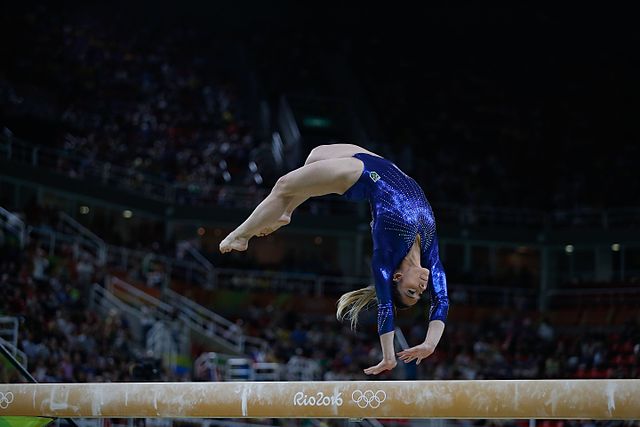Gymnastics: Difference between revisions - Wikipedia
 Article Images
Article Images
Content deleted Content added
Tag: Reverted |
m |
||
| (5 intermediate revisions by 5 users not shown) | |||
Line 33: '''Gymnastics''' is a type of [[sport]] that includes [[physical exercises]] requiring [[Balance (ability)|balance]], [[Strength training|strength]], [[Flexibility (anatomy)|flexibility]], [[agility]], [[Motor_coordination|coordination]], artistry and [[endurance]].<ref>{{Cite web |date=2023-12-22 |title=Gymnastics {{!}} Events, Equipment, Types, History, & Facts {{!}} Britannica |url=https://www.britannica.com/sports/gymnastics |access-date=2024-02-02 |website=www.britannica.com |language=en}}</ref> The movements involved in gymnastics contribute to the development of the arms, legs, shoulders, back, chest, and [[Abdomen|abdominal]] muscle groups. Gymnastics evolved from exercises used by the [[Ancient Greece|ancient Greeks]] that included skills for mounting and dismounting a horse, and from circus performance skills.<ref>{{Cite web |last1=Magazine |first1=Smithsonian |last2=Solly |first2=Meilan |title=A History of Gymnastics, From Ancient Greece to Tokyo 2020 |url=https://www.smithsonianmag.com/history/history-gymnastics-ancient-greece-tokyo-2020-180978270/ |access-date=2024-01-29 |website=Smithsonian Magazine |language=en}}</ref> The most common form of competitive gymnastics is [[artistic gymnastics]] (AG) The governing body for [[competition]] in gymnastics throughout the world is the [[Fédération Internationale de Gymnastique]] (FIG). Eight sports are governed by the FIG, including gymnastics for all, men's and women's [[artistic gymnastics]], [[rhythmic gymnastics]], [[trampolining]] (including double mini-trampoline), [[tumbling (gymnastics)|tumbling]], [[acrobatic gymnastics|acrobatic]], [[aerobic gymnastics|aerobic]], and [[parkour]].<ref>{{cite web |title=About the FIG |url=https://www.fig-gymnastics.com/site/about.php |publisher=FIG |access-date=May 31, 2019}}</ref> Disciplines not recognized by FIG include [[wheel gymnastics]], [[aesthetic group gymnastics]], [[TeamGym]], and [[mallakhamba]]. Line 45: {{See also|History of physical training and fitness}} Gymnastics can be traced to exercises performed in Ancient [[File: Friedrich Ludwig Jahn.jpg|thumb|upright|left|alt=color lithograph of the bust of an elderly white man with a bald head except for long white hair on the sides of his head and a long beard that extends to his average breast. His white collar is visible above a simple black coat. His eyes are locked on the viewer's and his countenance is serious but calm.|[[Friedrich Ludwig Jahn]], the "father of gymnastics"]] | |||